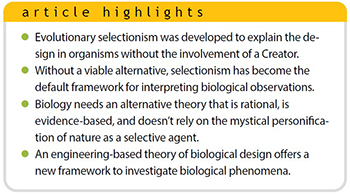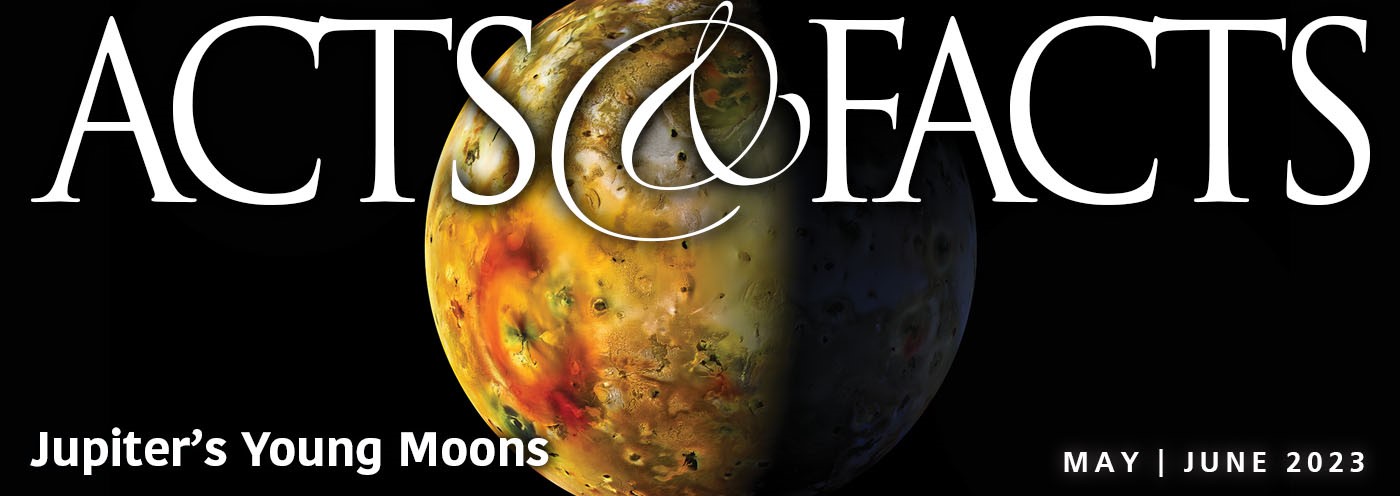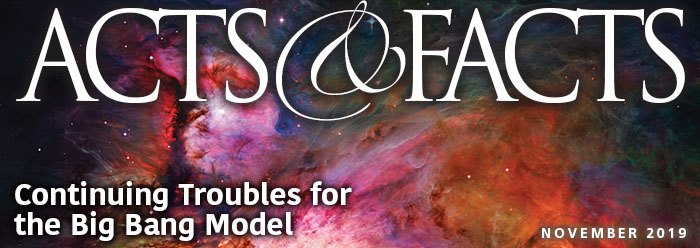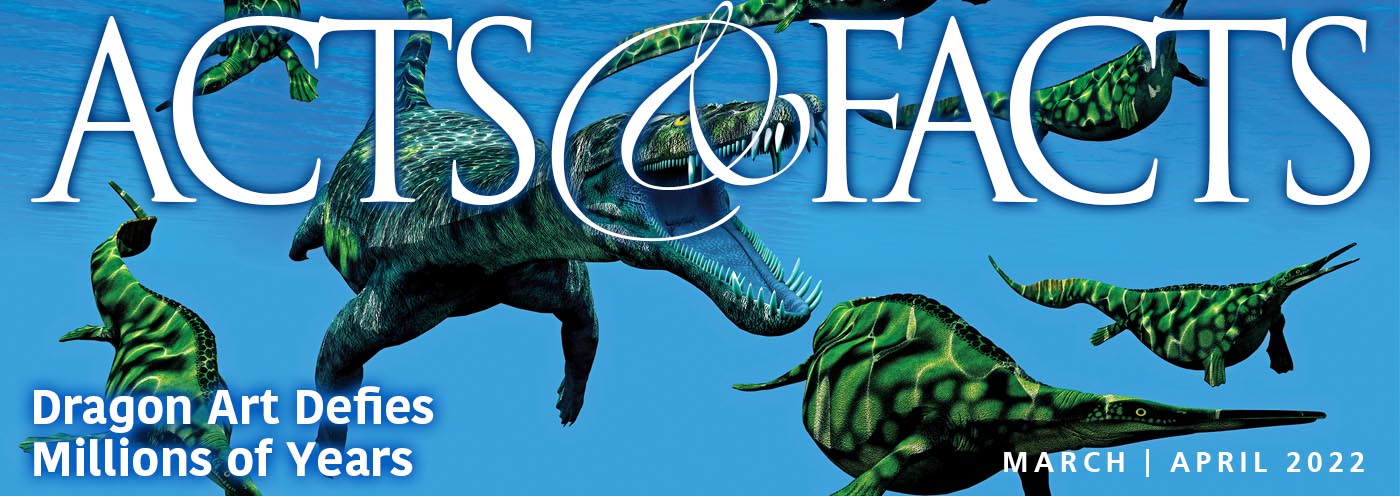Anyone who watches American football has observed a predictable inconsistency. When a pass is caught extremely close to the sideline, everyone with the offense immediately makes the arm signal for a completion, while those with the defense signal an incomplete pass. This is a great example of how opposite interpretations of the same observation can be reached by two people with contrary starting positions. It also helps explain the root cause of the creation-evolution controversy.
The Power of Theory Rests in the Story It Tells
 In science, the starting position is a theory. Theories essentially function as long narratives. When they’re taught to people, the stories place something akin to labeled cubbyholes in people’s minds for them to organize observations. The cubbyholes are arranged in such a way as to fill out different parts of the narrative. People will be guided by the labels as they interpret what they see, and then they’ll place their newly molded thoughts into the corresponding cubbyholes.
In science, the starting position is a theory. Theories essentially function as long narratives. When they’re taught to people, the stories place something akin to labeled cubbyholes in people’s minds for them to organize observations. The cubbyholes are arranged in such a way as to fill out different parts of the narrative. People will be guided by the labels as they interpret what they see, and then they’ll place their newly molded thoughts into the corresponding cubbyholes.
Yet, it’s not whether all the cubbyholes are filled but the narrative itself that provides the structure that shapes people’s thinking. The narrative always has a goal, and the goal of a theory is to guide people into a particular way of making sense of seemingly disconnected observations of nature.
We’ve all heard of the theory of evolution. The worldwide influence of that narrative is undeniable. It powerfully shapes people’s view of biology, though it’s likely that most people, including evolutionists, couldn’t explain its basic assumptions and how they shape (i.e., put the labels on the cubbyholes) the interpretations of biological observations. But the take-home message of the evolutionary narrative is clear—the diversity and apparent design of living creatures came about through natural processes without the need for a Creator.
Harvard’s legendary evolutionary theorist Ernst Mayr sums up the central importance of a narrative to Darwinism:
Darwin introduced historicity into science. Evolutionary biology, in contrast with physics and chemistry, is a historical science….Laws and experiments are inappropriate techniques for the explication of such events and processes. Instead one constructs a historical narrative, consisting of a tentative reconstruction of the particular scenario that led to the events one is trying to explain….The testing of competing historical narratives became the methods of evolutionary biology, outweighing experimentation.1
Mayr then delivers the take-home message:
Natural selection explains the adaptedness and diversity of the world….It no longer requires God as creator or designer….[the] creation, as described in the Bible…was contradicted by almost any aspect of the natural world. Every aspect of the “wonderful design” so admired by the natural theologians could be explained by natural selection.1
Negative Evidence Alone Can’t Dislodge Darwin’s Narrative
Yet, millions of people—and thousands of scientists—think Darwinian evolution is a nonsensical explanation for the incredible design of creatures. They sense that its atheistic implications are the key to its preservation despite the huge problems that have been highlighted for decades, like failed predictions, counterintuitive explanations, appeals to academic authority, and imagination that is used to fill massive gaps in the evidence.
Since we’re dealing with science, why won’t contrary evidence dislodge the narrative? There must be other factors involved that enable the theory to persist. And indeed, there are.
First, scientific theories—especially evolution—operate by peculiar rules that make them resistant to dying. The most important rule of evolutionary theory states that any thinking outside of the theory is unscientific and must be excluded from scientific narratives. Another rule is that “laymen” aren’t capable of determining their own labels for cubbyholes. They must receive what “experts” deliver to them. The rules also say it’s alright to place an observation in a cubbyhole, i.e., make it fit a theory, even if (for now) it takes great imagination to do so. The narrator is even allowed to re-label a cubbyhole today the opposite of what it was yesterday.
When someone objects that these rules unfairly protect evolution from falsification, evolutionists simply say, “Science is just self-correcting.” Thus, when faced with contrary findings, the narrative can bend enormously—but not break. The rules allow the narrative to assimilate nearly all observations and to outright exclude competing explanations.
Second, a scientific theory may be in first place, not because it’s good, but because it’s the only one in the race. It persists because it’s the only thing to mentally hold onto. Mutation-selection, it’s believed, offers at least some explanation for adaptation and diversity, and a flawed narrative provides more intellectual security than no narrative. Research shows that even scientists are tentative—if not afraid—to let go of one explanatory “handle” until there’s another to grab on to.2 The Darwinian narrative’s exclusivity and longevity have enabled it to permeate the thinking of virtually every segment of society.

Because the mutation-selection narrative has been the only game in town for so long, it’s the go-to story to explain adaptation for evolutionists and many creationists and Intelligent Design (ID) advocates. For example, if you show nearly anybody a river-dwelling fish with eyes and a cave-dwelling fish of the same kind with no eyes, then the cubbyholes they’ll reflexively place their observations into are labeled “random mutations,” which caused eye degeneration in the cavefish, and “survival of the fittest,” which selected for the eye-loss trait.
Both the full-blown versions of Darwinian mutation-selection and the lighter narrative (that ICR previously taught) are still the same thing. But even evolutionists are increasingly pointing out that Darwinian selection is misleading people into a form of mystical thinking by attributing volition and agency to nature.3,4
So, why do many continue to tell the mutation-selection story (i.e., Darwinism)? That’s all they’ve had to go by. No other narrative has been offered. Without a better alternative, many are afraid to let go of Darwinian selectionism. Simply pointing out problems with evolution isn’t a replacement narrative.
Scientific Theory Interprets Observations
Let’s take a look at evolution’s path to becoming today’s dominant biological theory. A theory is a narrative, but that doesn’t make it a made-up story, a hunch, or even a commonsense guess. It’s a working hypothesis meant to explain the origin of a natural phenomenon or how it works.
This hypothesis becomes the backbone of a tentative framework that’s supposed to interpret diverse observations in a way that ties them together and provides an explanation that’s reasonable and scientifically plausible (i.e., doesn’t appeal to imagination to fill in gaps). It’s called a working hypothesis because it’s used as the lens through which observations are interpreted, it shapes the research questions that are investigated, and it thus sets the research agenda.5
So, scientific theories powerfully constrain something of overwhelming importance within science—how observations are interpreted. Interpretations are the working-level thoughts that shape a person’s beliefs. Guiding interpretation is perhaps the most important role of theory, but that isn’t its central purpose.
Scientific Theory Answers Big Questions
The main purpose of a theory is to answer the big questions that exist in every field of study. What are the big questions in biology? Perhaps the most apparent is how life began. That’s big, but there’s something special about creatures. We observe distinctive characteristics that prompt the question: Were creatures designed by some being like us but greater than us? Questions that contain words like “design” or “engineering” inherently have theological implications.
Evolutionists recognize the big questions in biology and their theological implications as well as anyone. The evolutionary philosopher Peter Godfrey-Smith said:
The apparent design of organisms, and the relations of adaptedness between organisms and their environments, are the big questions, the amazing facts in biology. Explaining these phenomena is the core intellectual mission of evolutionary theory. Natural selection is the key to solving these problems; selection is the big answer.6
He summoned support from Richard Dawkins, adding:
The first chapter of The Blind Watchmaker…is an extended defense of the claim that apparent design in nature poses a uniquely important problem for the scientific worldview, and biology’s special task is to solve this problem.6
Evolutionists clearly understand the implied theology of this “apparent design” and know they need their own atheistic answers to the big questions. They’re confident their construct of natural selection provides these answers.
Harvard’s famed geneticist Richard Lewontin describes how evolutionary theory was developed to address the design of creatures as the most important question in biology.
Life forms are more than simply multiple and diverse, however. Organisms fit remarkably well into the external world in which they live. They have morphologies, physiologies and behaviors that appear to have been carefully and artfully designed to enable each organism to appropriate the world around it for its own life. It was the marvelous fit of organisms to the environment, much more than the great diversity of forms, that was the chief evidence of a Supreme Designer. Darwin realized that if a naturalistic theory of evolution was to be successful, it would have to explain the apparent perfection of organisms and not simply their variation.7
Big questions concerning biological adaptation are related to the apparent design of organisms. Evolutionary theorist Stephen J. Gould asked:
What is the motor of organic change? More specifically, how are life and the earth related? Does the external environment and its alterations set the course of change, or does change arise from some independent and internal dynamic within organisms themselves?8
So, some big questions in biology that any theory must answer are:
- How do we account for the impressive apparent designs of organisms?
- What explains the purpose observed in biological systems?
- Can nature function as an agent sufficient unto itself, or is an intelligent agent needed?
- What controls organisms’ responses to their environments?
- Are there limits to the process of biological adaptation?
Natural Selection: Darwin’s Design-Producing, Creative Force
Given the big questions and their own atheistic bias, Darwinists needed an unconscious creative agent that can sort through random mutations, select the best, and build “designed” organisms. Evolutionary theorist Francis Ayala confirms natural selection was intended to fill this role:
With Darwin’s discovery of natural selection, the origin and adaptations of organisms were brought into the realm of science. The adaptive features of organisms could now be explained, like the phenomena of the inanimate world, as the result of natural processes, without recourse to an Intelligent Designer….Darwin’s theory of natural selection accounts for the “design” of organisms, and for their wondrous diversity, as the result of natural processes, the gradual accumulation of spontaneously arisen variations (mutations) sorted out by natural selection….This was Darwin’s fundamental discovery, that there is a process that is creative, although not conscious.9

How selectionists devised a narrative that is fundamentally anti-intelligent design but still produces design is the topic of my next article.
Selectionism Today: The Go-To Answer to Big Questions
Is there currently a rival theory to contest selectionism as the go-to explanation for biological adaptation? Evolutionary selectionists claim their theory answers the big questions—especially about purpose, design, and agency. But they also claim selectionism is a robust framework for scientists to organize their thinking about all aspects of the diversity of life and that it’s the best way to approach biological research. In other words, they believe that without evolutionary theory biologists couldn’t do their jobs effectively.
Evolutionists bolster their case by opposing creationists and many ID advocates who declare that creatures didn’t evolve but were instead precisely and skillfully engineered. The selectionists assert that these critics have utterly failed to produce an alternative framework to interpret observations and offer “new avenues for research.”10 They underscore the lack of fresh thinking by noting that creation/ID selectionists have themselves accepted mutation-selection—the backbone of the Darwinian anti-design model of adaptation—as their major tenet for designed adaptation.11
Are these indictments true? Is selectionism the uncontested framework for interpreting adaptation and diversity? What would you say if an evolutionist asked you to tell him how the research questions being raised and investigative agenda being set based on a theory of “engineered creatures” are different from those of evolutionists?
Historically, creationists and many ID advocates claim they do have a “theory”: intelligent design is the best explanation for observations like irreducible complexity, specified complexity, and fine-tuning in nature. Evolutionary selectionists retort, “What kind of ‘theory’ is that?” They wouldn’t deny various biological complexities or that organisms appear designed, but they would say organisms only appear designed because mutation-selection is a powerfully “creative process” that offers a totally natural explanation for the origin of all biological complexity.12 Then they wait for a contrasting theory to contest their explanation.
Design-oriented selectionists respond that natural selection is actually a “conservative process” (some say it’s the God-ordained way to weed out the worst mutations from populations) that can cause incredible biological diversity only within specific creature kinds. Evolutionary selectionists disagree. They also still point out that using “conservative” rather than “creative” to describe selectionism still holds it to be a real, adaptive process squarely within Darwinian selectionism, so where’s the alternative theory? It isn’t an alternative theory if it merely differs in the degree of efficacy of the mutation-selection model. Selectionism remains without a serious challenger.
Replace Selectionism With a Theory of Biological Design
In sum, evolutionary theory is a narrative that guides people to think that a natural, purposeless process in which nature is personified as a selective, creative agent can answer the biggest question in biology. Namely, how did creatures get their incredible design? The influence of selectionism pervades even creationist and ID domains primarily due to its long persistence as the uncontested explanation of adaptation.
As noted earlier, the real work of theoretical narratives is to guide the interpretation of day-to-day observations. The lack of an alternative theory to selectionism is why evolutionists and creationists have presented essentially the same narrative for the origin of such phenomena as blind cavefish. At the Institute for Creation Research, we sense that the traits that enable some fish (and other creatures) to colonize caves result from those creatures’ ability to purposefully track environmental changes due to highly engineered, innate systems. We find it dishonoring to the Lord Jesus to say His mechanism by which creatures adapt today is the purposeless, deadly, clunky, and anti-design mutation-selection process. It’s clear that we need our own complete, engineering-based theory and interpretive framework based on what is opposite to assumptions of selectionism.
What would make up a theory of biological design (TOBD)? A TOBD needs to be a compelling, engineering-based narrative that can sweep away the cubbyholes of selectionism and offer a better foundation and new labels to use when interpreting observations that will then be placed into new cubbyholes. A TOBD will be far more intuitive, rational, and evidence-based by eliminating both imagination and the personification of nature as a selective agent. Details of a TOBD will be presented in part two on this topic.
Click here to read “Why Biology Needs A Theory of Biological Design, Part 2.”
Click here to read “Why Biology Needs A Theory of Biological Design, Part 3.”
Click here to read “Why Biology Needs A Theory of Biological Design, Part 4.”
References
- Mayr, E. 2000. Darwin’s Influence on Modern Thought. Scientific American. 283 (1): 79–83.
- Kuhn, T. S. 1962. Chapter 6: Anomaly and the Emergence of Scientific Revolutions. In The Structure of Scientific Revolutions. Chicago, IL: The University of Chicago Press.
- Reid, R. G. B. 2007. Biological Emergences: Evolution by Natural Experiment. Cambridge, MA: The MIT Press, 36–37, 393.
- Fodor, J. and M. Piattelli-Palmarini. 2010. What Darwin Got Wrong. New York, NY: Farrar, Straus and Giroux, 162–163.
- It’s important to note here that narratives are affected by their narrators, and the same goes for theories. Even scientific theories are rooted in the core, preexisting beliefs of a person or group, e.g., a biblical or materialistic worldview. Mayr acknowledges as much, saying, “First, Darwinism rejects all supernatural phenomena and causations” (Mayr, Darwin’s Influence on Modern Thought, emphasis added). Mayr’s worldview is the polar opposite of most of the great pioneers of science.
- Godfrey-Smith, P. 2001. Chapter 11: Three Kinds of Adaptationism. In Adaptationism and Optimality. S. H. Orzack and E. Sober, eds. Cambridge, NY: Cambridge University Press, 336, 339. Emphasis in original.
- Lewontin, R. C. 1978. Adaptation. Scientific American. 239 (3): 212–230.
- Gould, S. J. 1977. Eternal Metaphors of Palaeontology. In Patterns of Evolution as Illustrated by the Fossil Record. A. Hallam, ed. Amsterdam, NL: Elsevier, 2–3.
- Ayala, F. J. 2007. Darwin’s greatest discovery: Design without designer. Proceedings of the National Academy of Sciences. 104 (suppl 1): 8567–8573.
- Miller, K. 2008. Only a Theory: Evolution and the Battle for America’s Soul. New York, NY: Viking Penguin, 87.
- 11. Duff, R. J., T. R. Beatman, and D. S. MacMillan III. 2020. Dissent with modification: how postcreationism’s claim of hyperrapid speciation opposes yet embraces evolutionary theory. Evolution: Education and Outreach. 13: article 9.
- Ayala, F. J. 2007. Darwin’s Gift to Science and Religion. Washington, DC: Joseph Henry Press.
* Dr. Guliuzza is President of the Institute for Creation Research. He earned his Doctor of Medicine from the University of Minnesota, his Master of Public Health from Harvard University, and served in the U.S. Air Force as 28th Bomb Wing Flight Surgeon and Chief of Aerospace Medicine. Dr. Guliuzza is also a registered Professional Engineer and holds a B.A. in theology from Moody Bible Institute.






